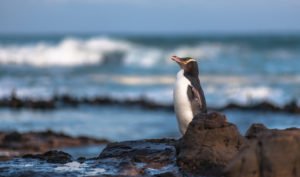Following three years of work, the South-East Marine Protection Forum has presented its final report on marine protection for the South Island’s south-east coast.
 The forum’s recommendations to the Conservation and Fisheries ministers include two alternative networks of Marine Protected Areas (MPAs): Network 1 includes six marine reserves and five MPAs with fishing restrictions; Network 2 includes three marine reserves and two MPAs with fishing restrictions.
The forum’s recommendations to the Conservation and Fisheries ministers include two alternative networks of Marine Protected Areas (MPAs): Network 1 includes six marine reserves and five MPAs with fishing restrictions; Network 2 includes three marine reserves and two MPAs with fishing restrictions.
The SMC asked experts to comment on the forum’s recommendations – the report is available on the forum’s website.
Professor Phil Seddon, Department of Zoology, University of Otago, comments:
“First of all the members of the South-East Marine Protection Forum are to be applauded for their efforts in this highly contentious area, their recommendations are clearly the compromised result of some strongly expressed views by the various stakeholders.
“The South Island of New Zealand is sadly lacking in marine protected areas, and unfortunately neither of the two recommendations of the Forum will do much to address this glaring absence. While both Network options are inadequate, Network 2 fails to provide any meaningful ecological protection at all.
“Pocket-handkerchief sized fragments of isolated protection will do little to assist the wide-ranging and iconic native seabirds such as hoiho, the yellow-eyed penguin, whose populations along the Otago coast continue to decline due to multiple factors, including fisheries-related habitat degradation and by-catch.
“Some hard decisions need to be made around whether we prioritise sustaining marginal economic activities, or conserve our dwindling and irreplaceable natural heritage.”
No conflict of interest declared.
Professor Liz Slooten, Department of Zoology, University of Otago, comments:
“The report of the South-East Marine Protection (SEMP) Forum is very disappointing.
“Scientists overwhelmingly asked for larger protected areas, buffer zones (e.g. Taiāpure area adjacent to, or around, no-take marine reserves) and better protection for mobile species including marine mammals, yellow-eyed penguins and other seabirds.
“The two proposals in the recommendations to the Minister of Conservation and Minister of Fisheries are based largely on social compromise rather than science.
“Given that the group was dominated by extractive users of the marine environment, the result was pretty predictable. This problem is well recognised, with similar expert criticism of the water forum as well. This kind of stakeholder group tends to result in the lowest common denominator, with the environment losing out almost every time.
“In this case, the best proposal was for 14 per cent of the area under consideration (out to 12 nautical miles offshore) being protected, with only 5 per cent of this fully protected in no-take marine reserves. The current world-wide target (IUCN) is 30 per cent of the marine environment highly protected (e.g. no-take marine reserves). In other words, six times what SEMP is proposing.
“The way to design effective marine protection is to start by outlining the science and conservation goals. For example, key principles of marine protected area design are to protect:
- endemic species diversity
- habitat diversity
- populations of key species
- connectivity between protected areas.
(Foley et al. 2010. Marine Policy 34: 210-955-966)
“The next step is to develop two or three options that would be biologically effective, implementing these key principles. Then, by all means, invite stakeholders and the public to suggest other options. On the condition that these alternatives must be as effective, or better than the science-based option(s). All options have to be measured against the same criteria. [For more information, see Fernandes et al. (2009 Ocean & Coastal Management 52: 439-447).]
“Such a process was recommended by scientists at the start of the SEMP process, but not followed.”
No conflict of interest declared.
Professor John Cockrem, School of Veterinary Science, Massey University, comments:
“A range of coastal and marine seabirds live on the Otago coast, including the threatened hoiho (yellow-eyed penguin). These birds will be affected by climate change as changes in sea temperatures lead to changes in food availability for the birds.
“The need for marine protected areas for seabirds is growing, and the Otago coastline is an especially important area for marine reserves. The proposed marine protected areas in network one, whilst generally small, will provide some protection of foraging areas for coastal seabirds. The small number and relatively small total area of the sites proposed in network two would be inadequate for the protection of foraging habitat for seabirds in Otago.”
No conflict of interest declared. Prof Cockrem has worked with kororā (little penguins) in Oamaru.